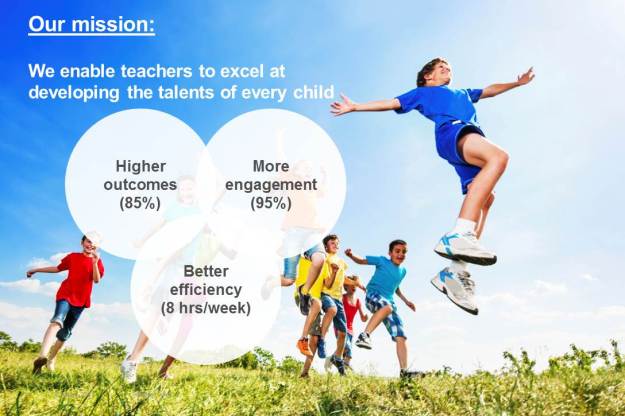
We believe it’s important to constantly improve the products and services we offer to our customers. More recently we have developed and introduced Sanoma Learning’s Impact Framework (SLIF) as a guide in this journey. This week I caught up with Sendhuran Govindan to learn more about the SLIF. Sendhuran’s a super-smart and nice guy, a clear thinker with a practical pair of hands.

Tell us about your background and role at Sanoma Learning Sendhuran
First, thanks John for having me on this virtual interview and for the opportunity to talk about SLIF. I am currently the Head of Strategy at Sanoma Learning. I joined Sanoma Learning 2 years ago and am passionate about our mission to develop the talents of every pupil. As Head of Strategy, I work with the leadership team to develop and execute our long-term strategy. I also lead specific strategic projects, one of them being SLIF.
My background is in strategy consulting and technology. I have spent over 10 years advising companies undergoing transformation due to technology, regulations, and other market conditions. Education is undergoing digital transformation, and it’s an exciting time to be here.
Why did we initiate the SLIF?
We have a long tradition at Sanoma Learning of developing excellent learning methods (an integrated set of learning resources for a subject, including textbooks, workbooks, software, supplementary resources, etc.). Some of our companies, like Van In and Malmberg, have been recognized leaders in educational publishing for over 100 years! As we shift towards making more hybrid and digital methods, we want to ensure that these new methods also deliver the high learning impact we are known for. We initiated SLIF to help us do that.
SLIF is our new way of developing methods and of evaluating their learning impact. Before we start developing any method, we set clear learning impact objectives and identify the features needed to achieve them. We then develop the method with the required features. After the method is launched, we evaluate the learning impact to see if the method and the features actually deliver on the objectives. By doing this, we can find out what works and what doesn’t, allowing us to continuously improve our methods further. This is very important as we are on the cutting edge of education technology. We have to ensure our innovation delivers learning impact, we are obsessed with that!
You mentioned Learning Impact. Can you elaborate?
With Learning Impact, we refer to 3 things: engaging pupils, improving learning outcomes, and improving teacher workflow efficiency.
We design and develop our learning methods to engage and motivate pupils to learn. For example, the story-fication in Bingel (our award winning learning platform), motivates students to do more practices exercises. This increased motivation, coupled together with our well-designed methods, help pupils learn better and reach higher learning outcomes.
Additionally, we design our methods to help teachers achieve more in their hectic schedules. For example, in most of our software, exercises are automatically corrected, and the teachers are provided with detailed insights on student performance. In some cases, our software even provides personalized recommendations per pupil. This saves the teacher a lot of time, which can be used to provide individual coaching to pupils.
What were the main results from last year?
Last year was the first year of SLIF. We incorporated SLIF in 3 of our 6 businesses. And we conducted pilots in 3 others. We found that it helped our publishers sharpen their focus on learning impact, and helped them think of how technology can be effectively used.
Additionally, we conducted our Sanoma Learning Impact Survey to evaluate the learning impact of our top 20 methods across Europe. We found that our methods had significant learning impact.
“85% of teachers said our methods helped improve engagement of pupils.”
“95% said that our methods helped them improve learning outcomes of their classes.”
“Teachers said that our methods helped them save 8 hours / week across planning, homework assigning & correction and test creation & correction. This gives teachers more time to individually coach pupils.”
What are we planning moving forward?
We have an exciting multi-year roadmap for SLIF. Currently, we evaluate our methods at a high level. We also have several different ways to evaluate the learning impact (surveys, pilots, big data, etc.). As we advance our learning analytics, we will standardize our impact evaluation and also drill down deeper to evaluate the impact of specific method components. This will make it much easier for us to improve our products in the future!
But our short term priority in 2016, is to complete the roll-out of SLIF to all our businesses and to expand our Sanoma Learning Impact Survey.
Using evidence to support improvement
Thanks Sendhuran for talking us through this. I see the importance of using evidence in assessing what works best for pupils and teachers and believe the SLIF can be a helpful guide.
Pingback: Working together to develop scalable technology at Sanoma Learning | John Richard Martin
Pingback: Child-friendly learning design at Bureau ICE | John Richard Martin
Pingback: Education reform in Finland | John Richard Martin
Pingback: Working together to develop scalable technology at Sanoma Learning – edtechgen
Pingback: Education Reform in Finland – edtechgen
Pingback: Organising for the digital transformation in Belgium – edtechgen
Pingback: High Five! | John Richard Martin
Pingback: Accelerating the digital transformation of education. Sanoma Learning acquires Iddink Group, a leading educational platform and service provider. | John Richard Martin
Pingback: Accelerating the digital transformation of education. Sanoma Learning acquires Iddink Group, a leading educational platform and service provider. – edtechgen
Pingback: Strongest result in our history so far at Sanoma Learning | John Richard Martin
Pingback: Strongest result in our history so far at Sanoma Learning | edtechgen
Pingback: Teachers value blended learning | John Richard Martin
Pingback: Teachers Want to Go Digital Where it Brings Most Benefits | John Richard Martin
Pingback: The future of education services for schools is in workflow | John Richard Martin
Pingback: Digitalization: examining the perspective of students toward Bingel learning platform
Pingback: Digitalization: examining the perspective of students toward Bingel learning platform - EssaysPrompt
Pingback: Digitalization: examining the perspective of students toward Bingel learning platform - Custom Writing and Editing Services
Pingback: How will AI impact teachers? | John Richard Martin